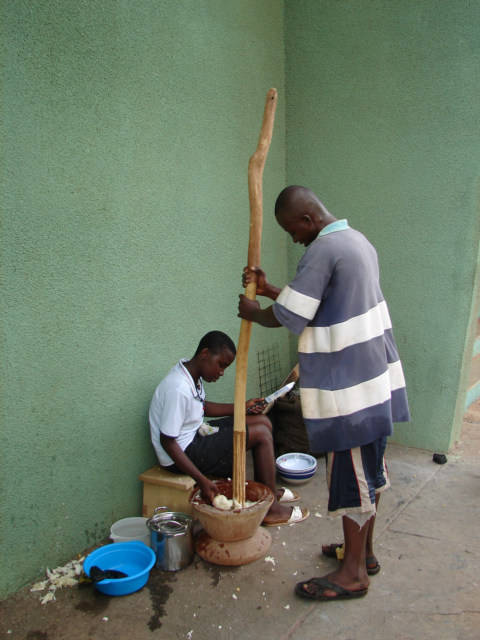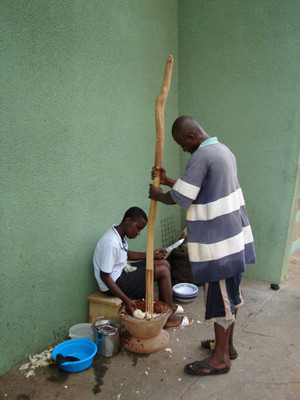Ghanaian Food
Posted by Heidi Baah on on Jul 1st 2018
Ghanaian Food
When you’re from another country, people love to ask how you like “American food” or how it compares to what you had in your homeland. This is certainly true for Kwame. I (Heidi) still like to ask him questions about Ghanaian food, and we’ve been married for four years! I also love that Kwame likes to cook. (He claims I took over the kitchen when we got married, but the truth is I’m happy to let him make meals for us whenever he pleases!) Just like his work designing shoes, Kwame views cooking as an artistic endeavor. When guests compliment him on his meals, he usually responds, “Cooking is an art!” He learned many of the traditional Ghanaian dishes from his mom growing up, but he has tweaked them since living in America to work with variations in available ingredients and to accommodate American taste buds (i.e. not sooo spicy hot!).
Many of Ghana’s typical dishes are very spicy, utilizing lots of hot peppers and ginger. People are often surprised at the “level of heat” Kwame likes. In fact, when we got married, it took a while for me to get used to the fact that he would add some chopped jalapeños and ginger to ANY dish I made to “give it flavor.” However, over the years, I’ve taken to adding more of these spices to dishes that I would never have considered in the past, so I’m learning to enjoy those flavors more myself!
“Flavorful” soups, stews, and sauces are served with dense carb dishes made from rice, plantains, or roots such as yams and cassava. One popular favorite for carbs is called “fufu.” This is somewhat like large dumplings, made from a laborious process of mashing boiled green plantains and cassava (or sometimes yams) in a huge mortar and pestle. Making fufu requires one person to pound with a huge, heavy stick while another person keeps folding the mixture over and over until it is creamy smooth.

When we were in Ghana, a friend of ours made fufu and let me try the pounding. I didn’t last very long because it takes some serious arm strength! Kwame said that it was a job he was required to do as a young person, and NOT one he liked…a good arm workout at an early age. I guess all the exercise kept him from gaining weight from this carb heavy meal, which is known in Ghana for packing on the pounds!
Since Ghana is a coastal country, it has many fish dishes. People usually cook and eat the whole fish, head and all, which is still Kwame’s favorite way to eat it! Chicken and goat meat were rarities for him, growing up so poor. He remembers Christmas as a day that he would get chicken, a big treat! Like fish, Ghanaians let none of the chicken go to waste. They cook all of it, chewing on the bones and sucking the marrow to enjoy and benefit from as much of it as possible. Kwame continues to enjoy gnawing and sucking chicken bones—another practice it took me a while to get used to! However, over time I have started trying it, not as much for enjoyment as for the health benefits. The bone’s cartilage and marrow are packed with good minerals like iron. Our toddler, Kwaku, is catching on and likes to suck on the outside of the bones a bit too!
Ghanaian's cook lots of soups and stews. Kwame is an expert soup maker. One of my favorites is his peanut butter soup. He makes this with either chicken or goat meat, both delicious! I’m including the recipe for this soup (chicken version) below, although it is tough to transcribe what he does into a written recipe. If you decide to try it, keep in mind that you can vary the amounts of the ingredients quite a bit, and it might take some experimentation to get the flavor and consistency you like. Start with less (especially of the peppers, ginger, garlic, onion, and peanut butter), and you can always add more as you try it. Remember, “Cooking is an art!”
Enjoy a little taste of Ghana, and remember to pray for
those there who don’t find it so easy to put food on the table.
How to make Kwame’sPeanut Butter Soup:
Please note these amounts are not exact. It might take some experimenting, especially with the aromatic spices/vegetables, to get the flavor you like. And this soup is even better on the second or third day as the flavors meld!
Ingredients:
1 whole chicken or about 4 chicken quarters
Note: If you desire no bones, you can use boneless—white and dark meat---OR boil the chicken (reserve broth!) and remove bones before proceeding with recipe…you’ll get more flavor and nutrients if you use the bones!)
Plenty of water and salt to taste
1 large onion, divided in half
4 large tomatoes
Approx 1-2 inches of fresh Ginger root, peeled and cut in bits suitable for blender
3-5 garlic cloves, peeled
2-4 Jalapeño or Serrano peppers, stems removed (can remove seeds if desired)
1/2-1 cup of creamy peanut butter (plain or with some sugar is fine)
Directions:
Cut the chicken, including the bones, into quarters or smaller segments, add to the pot, and lightly sprinkle with salt.
Chop half a large onion and add to the pot. (Reserve the other half of the onion.)
Barely cover the chicken with water. Bring to a boil then reduce heat and partially cover with a lid to simmer for about thirty minutes or until you can tell the chicken is thoroughly cooked.
Meanwhile, in a blender blend the other half onion, the ginger, garlic, and peppers with a little water, then add to the simmering pot of chicken. (Keep blender out for the tomatoes!) Add more water to the pot as needed to cover the contents.
Add whole tomatoes (core removed) to pot and continue to simmer for ten to fifteen minutes or until the tomatoes are soft. Put tomatoes in blender and puree, then pour back into pot.
Add peanut butter to the pot and stir in until well blended. Bring pot to boil for a few minutes then reduce to simmer for at least another twenty minutes or until you are ready to serve (allow a little time to cool off a bit!).
**If you leave the bones in as you cook, you can remove as much as possible before serving or try to enjoy them the Ghanaian way!
